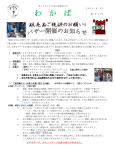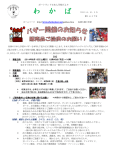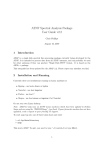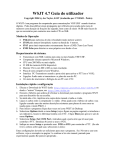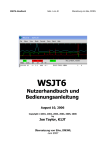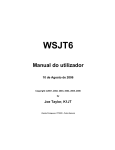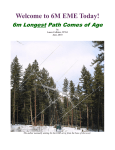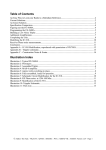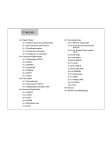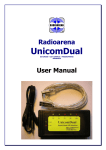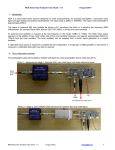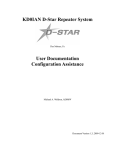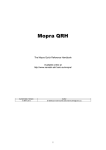Download Ragchew Quarterly - Blue Mountains Amateur Radio Club
Transcript
Ragchew Quarterly October - December 2003 The Big Discussion As most will have heard by now the ACA is looking to foster discussion about the possible changes following the WRC, from the ACA Website … The Australian Communications Authority (ACA) is reviewing regulatory and licensing arrangements for the amateur service. The ACA has released a discussion paper and seeks written submissions from interested parties in response to the paper. Background Article 25 of the Radio Regulations of the International Telecommunication Union (ITU) sets out the international arrangements for the amateur service. In This Issue BPL (Broadband Power Line) Recent studies in the USA have indicated that trials are going ahead and on the use of power lines for ‘Internet Broad-Banding.’ However, it is not without its problems and objections from the Amateur community both in the US, and Europe. We reproduce an ARRL issue, which is possibly being considered as a development in VK. The Moxon Pascal writes a wonderfully eloquent piece on the art of the Moxon and how he is prepared to risk his life for science!! The World Radiocommunication Conference (WRC) held from 9 June to 4 July 2003 in Geneva fundamentally changed Article 25. Jota continued on page 3 Is on this month. If you can spare the time, your local Scout or Guide centre will be happy to have Hams help with their activities. Even if you can only join in for a few hours the other Hams will appreciate the help. IN S I D E TH I S ISSUE Ubiquitous FT817 Club Outing to Parkes. Looking Back For Sale ‘Words are things; and a small drop of ink, Falling like dew upon a thought, produces That which makes thousands, perhaps millions, think’. Byron Blue Mountains Amateur Radio Club inc. Ragchew October – December 2003 Page 1 Management Committee 2003 – 2004 President Adrian Clout VK2BFN Vice President Stephen Chivers VK2AVW Secretary Kevin Purves VK2KEV Treasurer Roger Cooper VK2TEA [email protected] Ph.Mob. 0438-587238 Floor Members Peter VK2YX Peter VK2JBP Gunter VK2JAP Printing Courtesy of Ricoh Australia Ragchew is the publication of the Blue Mountains Amateur Radio Club Inc. Club Phone 0247593950 Website www.bmarc.oz-hams.org Postal Address P.O. Box 54 Springwood NSW 2777 Editorial Committee Comment What is a club? A club of our sort has a theme, in our case Amateur Radio. But what flows from that. If the comments that the committee seems to be getting a lot recently many members think that the production of a club newsletter is one of the main reasons for belonging to the group. Now of cause everyone cannot participate as much as they would like either in their club or their hobby. Work, family and health (or lack of any of them) will get in the way, and we have to set priorities. However, perhaps we should look at the purpose of a club magazine. If it is seen as a way of communicating with those who can’t physically make it to club meetings, one could ask, What for radio? Surely one of the prime purposes of radio is to communicate. Our club nets however are very poorly attended and when we ran a news broadcast we were hard pressed to get more than one or two callbacks at the conclusion. Is the purpose of the magazine to document the activities of the club and its members? We don’t have a full time committee (all the present members are employed, many self-employed) and certainly not a full time editorial team. It is therefore up to the individual members to write up their activities. However the editors of Ragchew (in all its forms) have always had problems with getting enough articles. The present quarterly format of Ragchew was partly conceived to allow more time to gather articles and to give the editorial team time to do the work of putting it together. But as the walrus said to the carpenter …’the time has come, the Walrus said to speak of many things’ … In the new year Daniel will be retiring and, apart from having even less time to play editor, will not be able to sponsor the excellent printing service that the present incarnation of Ragchew has relied on. This gives us time to think about what the next reincarnation of the club magazine should be and what it should be trying to achieve. In all probability the present editorial team will pass on the baton at the next AGM. Perhaps someone would like to put on the saffron robes and dream up the next reincarnation of Ragchew. The Blue Mountains Amateur Radio Club Inc, disclaims all responsibility for any losses or damages which may be attributed to the use or misuse of any article, or advice contained in this publication. Editorial Team Daniel VK2DC Kevin VK2KEV Roger VK2TEA Website of the year? Have you signed up to support this great effort? Check it out @ www.radiocorner.net Blue Mountains Amateur Radio Club inc. Ragchew October – December 2003 Page 2 continued from page 1 The changes to Article 25 have provided the ACA with an opportunity to review and simplify the current regulatory and licensing arrangements for the amateur service. The ACA has released a discussion paper that looks at the changes made to Article 25, as well as exploring future options for the amateur service in Australia. Public Meetings As part of the consultation process for this review, the ACA will be holding public meetings in cities around Australia. Sydney Tuesday 14 October 7.30pm–9.30pm Bankstown District Sports Club 8 Greenfield Parade BANKSTOWN Wednesday 15 October 7.30pm–9.30pm Hornsby RSL 4 High Street HORNSBY If you intend to attend one of the public meetings, can you please notify the ACA as soon as possible. Responses should be sent to Christine Allen on: Telephone: (02) 6219 5578 Facsimile: (02) 6219 5133 Email: [email protected] Submissions The ACA seeks submissions from interested persons on the issues raised in the discussion paper. Submissions must reach the ACA by close of business on 31 October 2003. Submissions must be made in writing and be addressed to: Manager Space and Terrestrial Systems Team Radiofrequency Planning Group Australian Communications Authority PO Box 78 BELCONNEN ACT 2616 Facsimile: 02 6219 5133 Email: [email protected] Please note that submissions will be made public on the ACA website unless otherwise specified. Persons providing a submission should indicate clearly whether any aspect of the submission should not be made public. However, even if a submission is not intended for public release, the ACA may be required to release it in accordance with statutory requirements such as requests made under the Freedom of Information Act. For clarification of any of the issues raised in the discussion paper, please contact: Email: [email protected] Phone: (02) 6219 5578 CQ 80 VK2 HZ portable 2 4 5 I had just finished the Moxon antenna, a monster that I had tamed by pegs and wire for the last two days. This gave me a break, so I could enjoy the VK2HZ Portable 245 vista, shown off amongst it's array of HF wire antennae and more whips than I had ever seen before. It was now time to test the Moxon antenna. The moment of truth had arrived. My heart started pounding while I hooked the antenna to a homebrew antennalyser. A read out revealed an indication of 46 kHz above the target frequency, R 45 minus J 6 of reactance at 3.646 MHz. The SWR was less than 1.2, wow! Relaxed, I gently connected the PL259 of an unknown coaxial cable (labeled in mil-spec part numbers) to my radio, a faceless carcass supposed to be an ICOM 738 and I was caught in a panorama of a fairy transition, that turned a technically minded head to a ‘sorta balun of literature.‘ "Cameron Corner reflected the last rays of the setting desert sun as it fenced straight into the twilight world, drowning all Dx-pedition members into it's grey- zone like a sinking boat. The scenic view was beyond all descriptive words. Darkness risen, challenged the apexes of the five 27 foot masts, still dangling religiously by weaving the last rays of hope to the macabre of an unfathomed cold night". "Enough!" I switched off my vague mind. . . I turned the power on, selected the 80m band, and pressed the "antenna A" switch. I heard no noise - the S meter seemed dead. Straining my eyes in the twilight, I spun the largest knob I could feel in the desperate hope that it was the tuning knob, seeking for any stretch of light to paint my antenna. In the act of hanging an 80M Blue Mountains Amateur Radio Club inc. Ragchew October – December 2003 Page 3 two elements Moxon beam, I walked innumerable steps - left nothing to chance, wearing under my clothes a pair of boxer shorts promoted by Viagra - to erect 5 masts secured by 400 metres of nylon rope and hung 71.245 metres of16 SWG copper wire. HF station at the rear of VK2JAP's Land Cruiser. In a gesture of "one for all and all for one", I handed the antenna over to Daniel VK2DC as a permanent replacement for the G5RV, that in the past two days had the expedition team had struggled to keep alive. I had traded personal safety for this wire when I made a frantic decision to spend my last minutes on the quest for bare copper wire instead of new tyre fittings. NB: I would like to express my gratitude towards: This resulted in a cruising over 1000 km of dirt road trepanned with pot holes and spiced with razor sharp rocks - all on a four wheel drive with only five millimetres of treaded tyres! Nothing heard, I left the 3.6 MHz and moved upwards... it was too early for the VK to be chitchatting on 80M, I reassured myself... -11 year old Jake, VK2JAP/F2, who spent two days helping me in the most hostile conditions. " LU2FA QRZ DX... ... LIMA UNIFORM TWO FOXTROT ALFA QRZ DX..." the radio blared. I copied that LU's station with a readability of 5 over a strength 5 of my S meter. What a feeling ! - I felt like the jumping camel on the Toyota advertisements. Psychological bitterness and organic flies that I swallowed during the last two days had finally paid off. It can't be happening, I told myself. An unreal atmosphere or at most fear perforated the surrounding area, which was defined by the two element beams descending to the earth like Jacob's ladder from heaven. I had vivified a dark black corny string of oxidized copper wire and brought it to its knees. The Moxon swung vigorously like a medieval catapult ran on adrenaline. -VK2ABQ, the founding father of the Moxon antenna. - Dxpedition members who bore my impenetrable spoken language with the most patient tolerance, -VK2JAP promising never leave anybody behind...he does not taking any prisoner? The expedition antenna mast (NATO code 5985/66/016/1977 ) has been superseded by the current model ( NATO code 5985/66/107/9535 ). Moxon Antenna can be found at http://www.cebik.com/moxpage.html Show and Tell November 2003 club meeting will be your chance to show of that latest kit or bit of home brew. Doesn’t have to be finished, could be just a box of bits you have scrounged at the last Trash and Treasure and have dreamt up a brilliant idea for. Show everyone that latest toy or what you have been pottering about with in the shack over that cold winter months. In my glorified hallucination, I saw the antenna's forward lobe darkened by zillions of desert flies - their buzzing would be frightened heard on all VK stations on the signal's southern path, a missing scene from " The Lord of the Rings : the Five Towers"... I borrowed a coupler from Dave VK2JDC to lengthen the coaxial cable and brought it to the “Just because we cannot see clearly the end of the road, that is no reason for not setting out on the essential journey.” JF Kennedy Blue Mountains Amateur Radio Club inc. Ragchew October – December 2003 Page 4 A HARD DAY AT THE OFFICE VK2HC I thought I would let everybody know just how hard and tough I have to do it to make a living. First up, a little info on the company I work for and the work I perform. RAD-TEL Systems pioneered the use of Radio Telemetry in Australia and currently service approximately 100 Councils, remotely controlling water supplies and sewerage networks utilizing UHF Radio Telemetry. They manufacture Remote Transmitting Units (RTU). Two types are used a small 3000 ideal for solar sites and a 5000 used in mains powered sites. Everything is manufactured in house, power supplies, analog, digital boards, repeaters, computers, software. Radios used are Communico, (yes still in use) Philips, Tait, Maxon, and the new kid on the block GME. I setup all the radios frequencies, power settings, deviation, sensitivity, and carry out field maintenance on the radios. A recent job was for Narrabri Shire Council, the area covered, Boggabri, Gwabegar, Pilliga, Wee Waa, Bellata, a 2650 Km round trip from Sydney over six days. They have 3 repeaters, one at Narrabri, one at Wee Waa, and the main one at Mt Kaputar, more to the point Mt Governor, a saddle between the two mountains. Between the hard work and wiping off the sweat, I was able to take some pictures. (I always thought those things were as useful as an ashtray on a motor bike but they do work sometimes) maybe it had something to do with the length of LD450 Heliax cable run??? At other sites we use 6 element yagi vertically polarized for the longer haul or ¼ wave vertical whip or coax cable antenna for the stealth sites slipped up a piece of conduit. Mt Governor repeater site hut and to the right the toilet, (very important creature comfort), main radio hut, water tank, back up diesel generator hut and two towers supporting a myriad of antennas for RTA, State Emergency, Police, Country Energy, Ambulance, and Forestry. Rodney VK2AJ tells me there are 180 licenses on the site, no wonder they need two towers. The club have two Diamond dual band 1.2 meters antennas they have been set-up in an interesting way, the UHF repeater is “diplexed” with both TX and RX signals combined to a single cable, the “diplexed” UHF signal is then “duplexed” with the receiver of the VHF repeater, and this UHF/VHF combination is connected to one of the antennas, the second (lower) antenna is used exclusively for the output of the 50W VHF transmitter. Coverage is over 2 hours hard traveling direction. The first one is what a UHF collinear antenna looks like after it has been hit by lightning, This one lived on top of the Wee Waa Reservoir, they lost two collinear antennas the same way. The other one was at Narrabri Reservoir and the repeater radios survived unscathed, we use surge arrestor at the radio end. Blue Mountains Amateur Radio Club inc. Ragchew October – December 2003 Page 5 interference free signals when the Scader system is upgraded to 900 Mhz. During the early days they have worked as far south as Peter Page VK2APP near Young. Inside the main hut is the Amateur Radio Repeater of VK2RNW (“NW” = “North West”) (take note Adrian), the very professional setup that consists of a 50W Philips 814 TX/RX for VHF, and a 50W 815 TX/RX for UHF. This shot (back to work now) is the Rad Tel setup for Narrabri Shire Council. Top: Power supply. Centre: Tait T2010 link radio, Bottom: Diplexer. On the door top: Remote head Tait 750 repeater and bottom speaker. The frequency used is in the 420 Mhz to 520 Mhz range narrow band, you can just make out a surge arrestor under the diplexer. The black thing, (circled) hanging off the microphone is a key to remove the T750 radio from its cradle. Behind the rack mount are the 2 metre and 70 cm cavities, the VHF repeater’s allocated output frequency is 146.625Mhz and UHF repeater’s output frequency is 438.455Mhz. John, VK2ZSI from Gunnedah, a member of North West Amateur Radio Group, maintains the repeater site. I am told he is the Guru and is instrumental in keeping the very good relationship with the other co site repeater users. On the floor below the Narrabri Repeater is the Rad Tel 3000 RTU. It’s sole purpose in life is to let everyone know their has been a mains power failure at the site. It has its own internal battery with a Maxon SD125 radio, along with a mains power plug pack to top up the battery. The club has had to strangle the radios due to the amount of RF on site, and are soon to enjoy Blue Mountains Amateur Radio Club inc. Ragchew October – December 2003 Page 6 The Antenna Towers in the Clouds. The structures just below the cables on the apex are called (“horse rails”) they stop the cables getting too close to ground. On cold windy days the power conductors become loaded with ice which imposes enormous strain on the supporting towers and the conductor itself, there have been reports of ice cylinders on the conductors up to 75mm in diameter, the weight of the ice causes the cables to sag 5-6 meters and rest on the insulated horse rails which are the required statutory distance from ground. Just imagine how much movement there would be as the wind whistled up the valley. The High Voltage, 22,000 volts Power lines going up to Mt Dowe. Mt Dowe is one of several mountains along the Nandewar Range and is located within the Mt Kaputar National Park, The Telstra mobile base tower and TV transmitter/translator tower are located here. Mt Kaputar is 1510 meters above sea level and at the summit you have a 360-degree view, there is no higher peak between Mt Kaputar and South Africa. Between the support towers on the final span from the valley to the edge of the plateau that is one of the longest in Australia, there are 2.08 kilometers of power line and a height difference of 427 metres. Each cable weighs about 1.5 tones and is spaced 12.2m apart. This picture taken on a good clear day gives a good indication of the height of Mt. Kaputar in relation to the rest of the Nandewar Range in the background. They used Helicopters to get the special cables up there. The cable consists of 7 x 2.75mm wire strands, 2 aluminum and 5 high tensile 120 ton grade steel. Blue Mountains Amateur Radio Club inc. Ragchew October – December 2003 Page 7 A National Parks and Wild Life officer also lives in the park. So if you want to get away from it, it’s the place to be. I had my Yaesu 817 with me and was hoping to work some 10m or 6 m DX from the summit, but the RF interference on HF was too overpowering. Next time you are sitting in your air conditioned car in the long car park, think of me out there doing it tough. I would like to thank John Sheehan VK2ZSI from Gunnedah for supplying extra technical information for this article and Rodney Bailey VK2AJ from Moree for their valuable assistance, and of course Ken Nisbet VK2KP - The Boss! These.two shots are of the Police UHF cavities just installed front and rear. Looking at Mt Dowe, from Mt Governor. The high voltage power going up to the Television Broadcast Tower you can just make the tower out in the center of the photo. It’s a pity I did not take theses photos on my first trip as it was clear The second trip, the next day was due to having the wrong set of keys to the site, Oh well maybe next time A striking feature as you drive up to the summit is the chimney shaped plug, called Ningadhun, and Yulludunida crater which dominates the landscape. The road up the mountain is very narrow, defiantly not suitable for caravans. There are two well-equipped camping areas with hot showers and electric barbecues also 2 well equipped cabins at Dawson’s Springs. Rodney Bailey VK2AJ switching the Repeater on. Blue Mountains Amateur Radio Club inc. Ragchew October – December 2003 Page 8 Looking Back Daniel VK2DC Club Historian Early in 1956, a campaign was launched to raise funds to build a transmitting station for the W.I.A., New South Wales Division. The WIA council considered that acquiring a site for the location of VK2WI was essential, and should be acted upon with some urgency. Land had been selected at Dural, and some field strength tests had been carried out. The site was considered ideal, as B.C.I. (Broadcast Interference), would be at a minimum for the 500 watts allowable, and the use of 40 and 80 metre’s, would give state-wide coverage under all conditions. September 1956 in Bill’s Moore’s column in Radio Television and Hobbies, he writes of the progress raising funds for VK2WI, Dural. At this time, an amount of £800 had been raised, and the building was progressing smoothly. The building was being built on foundations excavated by volunteer labour. Working bees were held on Sunday’s to construct the actual building. By October of that year, the fund had reached £850. Also, as with previous months, volunteers were required to help complete the building, (other than bricklaying,) and the contact was Jim Corbin, VK2YC. On telephone; MU1092. Jim Corbin, VK2YC attended the Commonwealth Government School of Civil Defence in Mt Macedon, Victoria to speak on behalf of Radio Amateurs and as current President of the N.S.W. Division of the W.I.A. While the event took place in late 1956, it was reported in January issue of RTV&H. 1957. Jim was able to express the Amateurs viewpoint and to report on the range of emergency nets run by amateurs in all states, not only VK2. The new home for VK2WI was nearing completion at this stage, due to the untiring work of VK2EN, and councillor VK2AHP. Both these gentlemen spent more than their fair share of time to ensure the project was to be completed. To get VK2WI on the air a Transmitter was presented to the Wireless Institute by Chas Maclucan, VK2CM. ) Just a couple to laugh at! Who’s done this before? Blue Mountains Amateur Radio Club inc. Ragchew October – December 2003 Page 9 Wireless Institute Technical Bookshop Books – Kits - Antennas Rockmite QRP Transceiver Kits 20 or 40m $55 member / $65 each non member Direct from the U.S. ! now QST Magazine Join the Wireless Institute now and save ! $8.00member/$10.00non member Special Order…EH Monoband antennas Direct from manufacturer in Europe ! POA (80 metre version shown) BIG savings ! Web: http://www.wiansw.org.au Email: [email protected] Tel +61 2 9689 2417 Fax: Wireless Institute of Australia Technical Bookshop PO Box 432 Harris Park NSW 2150 Located at 109 Wigram St Parramatta Just down from the railway station. Blue Mountains Amateur Radio Club inc. Ragchew October – December 2003 Page 10 Pushing the Limits By Guy VK2KU One of the things I like doing is pushing the limits of distance I have worked on the different VHF and UHF bands, always looking for ways to increase my best distance with each mode and band. This is an informal competition against myself and also against other stations. And if I can do better at one thing than anyone else in Australia (or even just in NSW), then there may be a National or State distance record to be broken. There has been a big surge in VHF activity using Digital modes like FSK441 and JT44 in the last year or two, and because the digital records are still well below their natural limits, they are there for the taking. Maybe someone else will take it from you after only a week, but there is an enormous satisfaction in being the best, even if it's only for 5 minutes! You don't need to be a super-station to do this, though it certainly helps to have a decent setup! Much of it is luck in being there at the right time when the contact is possible. Right now on 25th July 2003 I am fortunate enough to hold 2 National (Digital) records and 1 NSW State Record. Tomorrow, who knows? NSW State Distance Record on 1296MHz From the moment I splashed out at Wyong in 1997 on the 10W 1296MHz module for my FT736R, I knew this record was there for the taking, given a good duct across the Tasman, and of course a ZL station at the other end. Gordon VK2ZAB held it before me for a contact in January 1997 with Brian ZL1AVZ in the Auckland area, a distance of 2145km. I lived some 50km further west than Gordon! I built a box of 4 yagis, each with 30 elements, to give myself plenty of antenna grunt to make up for the relatively low power. My chance finally came on 3 March 2000, quite late in the ducting season. In mid afternoon Nick ZL1IU was booming in at 5x8 on 144MHz; Nick is often the first ZL we hear when 144MHz opens. Other ZLs joined in, but none with 1296MHz. I had worked Brian ZL1AVZ before on 144MHz, so at around 5pm I picked up the phone and called him. Fortunately Brian was home, and immediately agreed to head out to his weekender at Muriwai, on the coast west of Auckland, where he had his 1296MHz dish. We made contact on 144MHz just after 6pm (5x7, 5x9), and then moved straight up to 1296MHz. There was a moment of panic when I couldn’t hear anything on 1296MHz. Just calibration problems with a 6kHz difference between us! After that we completed easily with 5x5 reports both ways. We could have done it with just 1W and a single yagi given those conditions. So, 2195km and my first record. Finally we moved down to 432MHz to complete the trifecta (5x6 both ways). Then I rang Gordon VK2ZAB! He joined us on 1296MHz for a ragchew along with other VKs. But it's only a matter of time. When John VK2TK gets set up on 1296MHz in Wentworth Falls, and gets a duct with someone at the other end, he will take the record from me and good luck to him. Of course I may just head up to Narrow Neck with some portable gear if I get around to building a portable yagi for 1296 in time! Blue Mountains Amateur Radio Club inc. Ragchew October – December 2003 Page 11 National Digital Record on 432MHz This was an easy one, which came right out of the blue! Rex VK7MO has been a great mover and shaker for all the Digital modes in the last year or two, especially since Joe Taylor K1JT produced his WSJT software with the FSK441 Meteor Scatter mode and the JT44 Weak Signal mode. I joined the digital band in October 2002 working Rex as my first digital contact using FSK441 on 144MHz. My first JT44 contact was in late November, again with Rex who was in a rare grid-square on 432MHz. We couldn't quite make it on SSB, so we turned to JT44. I stuffed my 100W 432MHz brick in that contact, because I didn't have a fan on it didn't think you needed one, but the brick ran very hot with full carrier for 30s at a time, once a minute. So I was still a novice on JT44 when on 30 December 2002 a duct opened up to southern ZL, with Bob ZL3TY in Greymouth the outstanding signal. I worked Bob on 144 and 432MHz SSB without difficulty around 9pm local time. At 7am next morning both bands were still wide open with signals 2 to 3 S-points stronger than the previous night, but I was blind to the opportunity until Mike VK2FLR arranged with Bob to QSY up from 144 to 432MHz to try JT44! At this time the National Digital record on 432MHz was only 586km (VK7MO again). I followed them up onto 432MHz to listen. The next 20 minutes are amongst the most frustrating of my life. Mike was of course pounding into Hazelbrook from Glebe, and Bob, ZL3TY was also a huge signal from my elevated location looking right into the mouth of the duct off Sydney. But Mike and Bob couldn't hear each other at all. Eventually after 20 minutes I called Mike on SSB in one of his listening periods, and asked if I could have a go, and Mike graciously agreed. Five minutes or so later it was done, a very easy digital contact over 2055km. Nothing weak-signal about it, and we immediately switched to 432MHz SSB to celebrate. It was just a case of being there at the right time. Again, John VK2TK will surely take this record from Wentworth Falls next summer with the extra 10 or 15km! Come to think of it, I do have a portable 432MHz beam! Narrow Neck here we come - I must get a mast plus a way of fixing it to the vehicle. National Digital Record on 1296MHz This one didn't just happen, but really was planned carefully. The existing digital record was 587km, Rex VK7MO yet again from Hobart to Melbourne. I needed someone with 1296MHz gear over a long enough path with aircraft enhancement. Peter VK3KAI in Churchill seemed the obvious choice, a distance of 625km. Peter and I work regularly on 144MHz SSB from the southbound Sydney-Melbourne flights with a window of 2 to 3 minutes and signals up to about S5. We have done it once or twice on 432MHz SSB, very marginal at 4x1, and a shorter window due to the narrower diffraction pattern off the plane at the higher frequency. 1296MHz ought to be possible with the 25dB greater sensitivity of JT44. So we set up a schedule for 30 minutes, and heard - nothing. Never give up! Jim VK3ZYC at Longford had gear and a bigger dish. Ralph VK3WRE could lend him a 100W amplifier. The only problem was the distance - only 579km, 8km too short, but a good feasibility test! I did some extended monitoring of the Gippsland 2m beacon to establish the best schedule time with the most planes, and a 747 (QF2) on certain days as well. Jim arranged to go into work late on one of the 747 days, and we made the contact, but not a record. The time window from each plane was only about 30s as the plane flew diagonally across the radio path at an angle of 20 degrees. So we made only one, or at most 2 transmissions per plane. Blue Mountains Amateur Radio Club inc. Ragchew October – December 2003 Page 12 Meanwhile Peter had hoisted a dish up his tower, but had fried his preamp in the previous attempt. As soon as Jim and I completed our contact, up came Peter. It took us 51 minutes and umpteen planes to exchange all the necessary call-signs, reports and rogers. And there it was - 625km. Not exactly ground breaking stuff perhaps, but a new digital record on 1296MHz, and possibly the first digital contacts on 1296MHz using aircraft enhancement. How long will it last? Not very long, I think. I am already planning the next one on 1296MHz. Brisbane is obviously possible using aircraft (700km), and the window should be longer because the radio path is closely aligned with the flight-path. Next summer, Hobart should also be possible with a long window if we get some half-reasonable ducting. And there is always ZL, though that won't happen until someone with an interest in Digital modes and some 1296MHz gear appears over there. Breaking records is not about glory. It's about having fun, and pushing the limits out a bit further each time. You could do it too. Guy VK2KU VH-DX Group The VHF-DX group net can be heard on the Blue Mountains 2 metre repeater and on IRLP Sydney reflector on Sunday mornings after the WIA broadcast On the subject of Interference! Blue Mountains Amateur Radio Club inc. Ragchew October – December 2003 Page 13 BPL - (Broadband Power Line) Reprinted in part from ARRL - (with kind permission) Recent studies in the USA have indicated that trials are going ahead and on the use of power lines for ‘Internet Broad-Banding.’ However, it is not without its problems and objections from the Amateur community in the US. The following information is reproduced with kind permission from the ARRL. "BPL is the most crucial issue facing Amateur Radio and the one that has the most devastating potential," In terms of interference potential on HF and low-VHF frequencies, "nothing is on the same scale as BPL." A form of power line carrier (PLC) technology, BPL would use existing low and medium-voltage power lines to deliver broadband services to homes and businesses. Because it uses frequencies between 2 and 80 MHz, BPL could affect HF and low-VHF amateur allocations wherever it's deployed. BPL proponents--primarily electric power utilities--already are testing BPL systems in several markets, and one reportedly is already offering the service. FCC rules already allow BPL, although industry proponents want the FCC to relax radiation limits. It's feared such a change could exacerbate BPL's interference potential. At the West Gulf Division Convention (Austin Summerfest 2003) August 1-2 in Austin, Texas, a short video was shown that covered highlights of a recent field tour by ARRL Lab Manager Ed Hare, W1RFI. The video, which will complement technical data ARRL is gathering and compiling, turned out to be a real eye-opener for many in the audience. Walt Dubose, K5YFW--assistant chairman of the ARRL High Speed Multimedia (HSMM) Working Group--said it was about what he'd expected. "But for most attending--maybe 60 percent--it was much worse than they had imagined, and for some it was a real shocker," he reported. Dubose said a few of those viewing the video simply couldn't believe that BPL actually was causing the high noise level. In late July, Hare travelled some 1350 miles to visit BPL trial communities in Maryland, Virginia, Pennsylvania and New York to take measurements over significant parts of the HF spectrum. He also took initial readings at low-VHF frequencies. Driving a specially equipped vehicle loaded with radio gear and measurement devices, Hare said he didn't need to look long or track down "a few hot spots" to find BPL interference. "The signals were all over," he said. "The interference found ranged from moderate to extremely strong," Hare said. the speaker emits a crackling din, which one observer described as sounding like a Geiger counter. Only the very strongest amateur signals broke through on 20 and 15 meters. Hare noted that the field strengths of the various systems all were within FCC Part 15 limits for power line carrier (PLC) devices. This is something that is being addressed in VK, hopefully with positive government reaction. Blue Mountains Amateur Radio Club inc. Ragchew October – December 2003 Page 14 The Ubiquitous FT817 Bob VK2BYF Some possible problems The FT-817 Transceivers have a habit of frying the final and/or driver transistors. If the final unit fails, it is usually only one FET that is destroyed, but power output will be very low due to the loading effect of the other FET. The final unit is relatively easy to replace but DO NOT forget to set the bias or idling current. Individual FETs cannot be replaced. I'm not sure what causes the FET to fail, but I strongly suspect it is either transmitting without an antenna when the CPU has selected the rear or front antenna. This, as you are aware is programmable for each band. Insert a milliamp meter in series with the supply to the final unit, the wire towards the front of the Final Unit. Set TVR for 14MHz, SSB mode, No sound into the mike, i.e. No RF drive to the final unit. Turn both trim-pots fully anticlockwise. Then, by turning them individually a little clockwise and observing the final unit current drain you can tell which FET has died. If one trim-pot has no effect, you need to replace the final unit. After replacing the final unit, turn both trimpots fully anticlockwise. Set VR5402 (front) for 40mA final unit current; adjust VR5401 (rear) to 65mA total current drain for the 2 FETs. This is slightly less than what the service manual recommends but the FETs are happier and share the load better. Re-solder the supply wire. I have never had a complaint of distortion. Do not fiddle with the service menu to try and get more than 5Watts o/p it makes little difference and you run the risk of destroying your radio and your warranty. Driver transistors, 2 FETS in parallel. This one is not as frequent as the final unit but can cause a more expensive repair because the FET can burn a hole in your PA/LPF module, Once the circuit board turns to carbon it’s difficult to fix and expensive to replace. Check idling currents as above. 30mA for the pre-driver, measured at jumper J3005 (front) adjusted by VR3001 (front)., 20mA for drivers measured at J3006, adjusted by VR3002 (rear). This one is often set too high from the factory. Others have discussed free banding, -- why bother? If you must! Short the first 4 blobs from the left on the back of the control unit and reset the radio by holding VFO / MEM and F key while switching the radio on. Now reprogram all your memories. Tune Up Day The BMARC is having a tune up day for those who own an FT 817, on Saturday October 25th at the Scout Hall, Reading Street Glenbrook, starting at 14.00 hours. Blue Mountains Amateur Radio Club inc. Ragchew October – December 2003 Page 15 Parkes Outing. David, VK2JDC has organized a visit to the Parkes Telescope, on the Weekend of the 1st and 2nd of November. A tour has been arranged for the many visiting ham’s and wives, girlfriends, or both! Parkes in the Central West of N.S.W., approximately 375 Km from Sydney. (God’s Country) The club has arranged a bus for those who are not driving. For departure time, you will need to monitor the Club nets and / or catch Gunter (VK2JAP), on air. Promises to be another fun weekend, cricket in the dish? The Telescope is located North-ish of Parkes itself. (Circled) Accommodation has also been arranged for those who want to ‘swan it ‘ at a Motel in the centre of Parkes, and as far as I am aware, they have been advised, I know I have. I, personally am looking forward to this weekend to meet many new faces, and make friends, maybe to catch up with some old friends, who knows! So BMARC members, wear your club badge. Blue Mountains Amateur Radio Club inc. Ragchew October – December 2003 Page 16 For Sale Yaesu FT415 - 2Metre Hand Held. Charger (Car & AC), Manual, Remote Mic, In original Box.. $350.00. VK2DC QTHR Icom - IC505 - 6 Metre Tranceiver SSB – AM – No FM module. As new $275.00. VK2DC QTHR Where is everything? Got anything for sale? Well let us know. Drop me a line by email or snail mail. If you need a photograph taken let me know and I can come round with a Digital Camera. Remember we also have a For Sale section on the club web site. Editor; Roger Cooper VK2TEA Email [email protected] Mobile phone 0438-587238 Snail Mail P.O. Box 50, Woodford, NSW 2778 WebSite www.bmarc.oz-hams.org Have you looked at all the information on the club we site lately? Geoff’s be doing a great job of revamping it and it is well worth spending some time checking out its many features. Remember this is our resource for getting our message out into the internet world. So if there is something you want to get out, like a trip to some remote place, ask Geoff to put something together for you. Repeaters The Blue Mountains Amateur Radio Club inc operates Repeaters on the following bands; 2 Metres 147.050 + 70 Centimetres 438.375 – 6 Metres 53.870 – Under Construction -10 Mtr Repeater. Blue Mountains Amateur Radio Club inc. Ragchew October – December 2003 Page 17 Ragchew: A publication of the Blue Mountains Amateur Radio Club inc P.O. Box 54,Springwood N.S.W. 2777 Blue Mountains Amateur Radio Club inc. Ragchew October – December 2003 Page 18


















